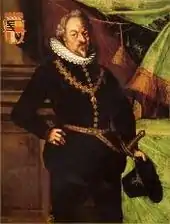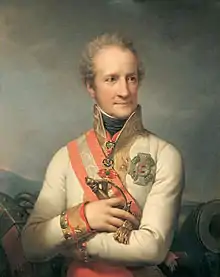Succession to the Liechtensteiner throne
Succession to the Liechtensteiner throne is governed by the house laws of the Princely Family of Liechtenstein, which stipulate agnatic primogeniture. In 2004 the head of state, Hans-Adam II, publicly responded to criticism from a committee of the UN which had voiced concerns about the exclusion of women from the line of succession, stating that the rule was older than the state itself.
| Part of a series on |
| Orders of succession |
|---|
| Monarchies |


.jpg.webp)
Succession rules
In 1606, the first prince of Liechtenstein, Karl I, and his younger brothers, Maximilian and Gundakar, signed Family Covenant, agreeing that the headship of the family should pass according to agnatic primogeniture to the heir of the most senior line.[1] The family continued to be governed by various statutes until 1993, when it was decided that some of the provisions were outdated and that they should be amended. The statute was repealed on 26 October,[2] and the new house law was published on 6 December.[3] According to the house law, the right to succeed to the throne of Liechtenstein is reserved for male patrilineal descendants of Prince Johann I Joseph born to married parents, excluding issue born of marriage to which the sovereign did not consent. Should there be no more eligible male patrilineal descendants left, the sovereign has the right to adopt an heir presumptive. It is explicitly stated that if a member of the princely family adopts a prince who is in the line of succession, the adoptee's place in the line will not be altered.[3] There is no scenario under which a woman could succeed to the throne of Liechtenstein.[4] The house law also provides for a possibility of renunciation of succession rights.[3]
Line of succession
 Prince Johann I Josef (1760–1836)
Prince Johann I Josef (1760–1836)
 Prince Alois II (1796–1858)
Prince Alois II (1796–1858)
 Prince Johann II (1840–1929)
Prince Johann II (1840–1929) Prince Franz I (1853–1938)
Prince Franz I (1853–1938)
- Prince Franz de Paula (1802–1887)
- Prince Alfred (1842–1907)
- Prince Alois (1869–1955)
 Prince Franz Josef II (1906–1989)
Prince Franz Josef II (1906–1989)
 Prince Hans-Adam II (born 1945)
Prince Hans-Adam II (born 1945)
- (1) Hereditary Prince Alois (b. 1968)
- (2) Prince Joseph Wenzel (b. 1995)
- (3) Prince Georg (b. 1999)
- (4) Prince Nikolaus (b. 2000)
- (5) Prince Maximilian (b. 1969)
- (6) Prince Alfons (b. 2001)
- (7) Prince Constantin (b. 1972)
- (8) Prince Moritz (b. 2003)
- (9) Prince Benedikt (b. 2008)
- (1) Hereditary Prince Alois (b. 1968)
- (10) Prince Philipp (b. 1946)
- (11) Prince Alexander (b. 1972)
- (12) Prince Wenzeslaus (b. 1974)
- (13) Prince Rudolf (b. 1975)
- (14) Prince Karl Ludwig (b. 2016)
- (15) Prince Nikolaus (b. 1947)
- (16) Prince Josef-Emanuel (b. 1989)
- Prince Karl Alfred (1910–1985)
- (17) Prince Andreas (b. 1952)
- (18) Prince Gregor (b. 1954)
- Prince Georg Hartmann (1911–1998)
- (19) Prince Christoph (b. 1958)
- Prince Heinrich Hartneid (1920–1993)
- (20) Prince Hubertus (b. 1971)
- Prince Johannes (1873–1959)
- Prince Alfred (1907–1991)
- (21) Prince Franz (b. 1935)
- (22) Prince Alfred (b. 1972)
- (23) Prince Franz (b. 2009)
- (24) Prince Lukas (b. 1974)
- (22) Prince Alfred (b. 1972)
- Prince Friedrich (1937–2010)
- (25) Prince Emanuel (b. 1978)
- (26) Prince Leopold (b. 2010)
- (27) Prince Heinrich (b. 2012)
- (28) Prince Ulrich (b. 1983)
- (25) Prince Emanuel (b. 1978)
- (29) Prince Anton (b. 1940)
- (30) Prince Georg (b. 1977)
- (21) Prince Franz (b. 1935)
- Prince Johannes (1910–1975)
- (31) Prince Eugen (b. 1939)
- (32) Prince Johannes (b. 1969)
- (31) Prince Eugen (b. 1939)
- Prince Alfred (1907–1991)
- Prince Alfred Roman (1875–1930)
- Prince Hans-Moritz (1914–2004)
- (33) Prince Gundakar (b. 1949)
- (34) Prince Johann (b. 1993)
- (35) Prince Gabriel (b. 1998)
- (36) Prince Alfred (b. 1951)
- (37) Prince Karl (b. 1955)
- (38) Prince Hugo (b. 1964)
- (33) Prince Gundakar (b. 1949)
- Prince Heinrich (1916–1991)
- (39) Prince Michael (b. 1951)
- (40) Prince Christof (b. 1956)
- (41) Prince Karl (b. 1957)
- Prince Hans-Moritz (1914–2004)
- Prince Karl Aloys (1878–1955)
- (42) Prince Wolfgang (b. 1934)
- (43) Prince Leopold (b. 1978)
- (44) Prince Lorenz (b. 2012)
- (43) Prince Leopold (b. 1978)
- (42) Prince Wolfgang (b. 1934)
- Prince Alois (1869–1955)
- Prince Alfred (1842–1907)
- Prince Eduard Franz (1809–1864)
- Prince Aloys (1840–1885)
- Prince Friedrich (1871–1959)
- Prince Aloys (1898–1943)
- Prince Luitpold (1940–2016)
- (45) Prince Carl (b. 1978)
- Prince Luitpold (1940–2016)
- Prince Alfred (1900–1972)
- Prince Alexander (1929–2012)
- (46) Prince Christian (b. 1961)
- (47) Prince Augustinus (b. 1992)
- (48) Prince Johannes (b. 1995)
- (49) Prince Stefan (b. 1961)
- (50) Prince Lukas (b. 1990)
- (51) Prince Konrad (b. 1992)
- (52) Prince Emanuel (b. 1964)
- (53) Prince Josef (b. 1998)
- (46) Prince Christian (b. 1961)
- Prince Alexander (1929–2012)
- Prince Aloys (1898–1943)
- Prince Friedrich (1871–1959)
- Prince Aloys (1840–1885)
Discrimination concerns
In 2004, a United Nations committee questioned the compatibility of agnatic primogeniture, which prevents women from becoming head of state of Liechtenstein, with the International Covenant on Civil and Political Rights[5] and later raised concern about it.[6] In response to the United Nations' demands for gender equality in 2007, Prince Hans-Adam II explained that the succession law is older than the Principality of Liechtenstein itself and that it is a family tradition that does not affect the country's citizens; the Constitution of Liechtenstein stipulates that succession to the throne is a private family matter.[7]
See also
- List of princes of Liechtenstein
- List of heirs to the throne of Liechtenstein
References
- "A Brief History of the Princely House of Liechtenstein". Embassy of Liechtenstein in Washington, D.C. Retrieved 16 February 2013.
- "House Laws". Princely House of Liechtenstein. Archived from the original on 15 June 2012. Retrieved 16 February 2013.
- "The Succession to the Throne". Princely House of Liechtenstein. Archived from the original on 27 June 2013. Retrieved 16 February 2013.
- Eccardt, Thomas M. (2005). Secrets of the Seven Smallest States of Europe: Andorra, Liechtenstein, Luxembourg, Malta, Monaco, San Marino, and Vatican City. Hippocrene Books. ISBN 0781810329.
- Report of the Human Rights Committee: Vol. 1: Seventy-ninth session (20 October - 7 November 2003); eightieth session (15 March - 2 April 2004); eighty-first session (5-30 July 2004). United Nations Publications. 2004. ISBN 9218101722.
- Report of the Committee on the Elimination of Discrimination Against Women: Thirty-seventh Session (15 January-2 February 2007), Thirty-eight Session (14 May-1 June 2007), Thirty-ninth Session (23 July-10 August 2007). United Nations Publications. 2007. ISBN 978-9218200273.
- Pancevski, Bojan (19 November 2007). "No princesses: it's men only on this throne". The Times. Retrieved 16 February 2013.